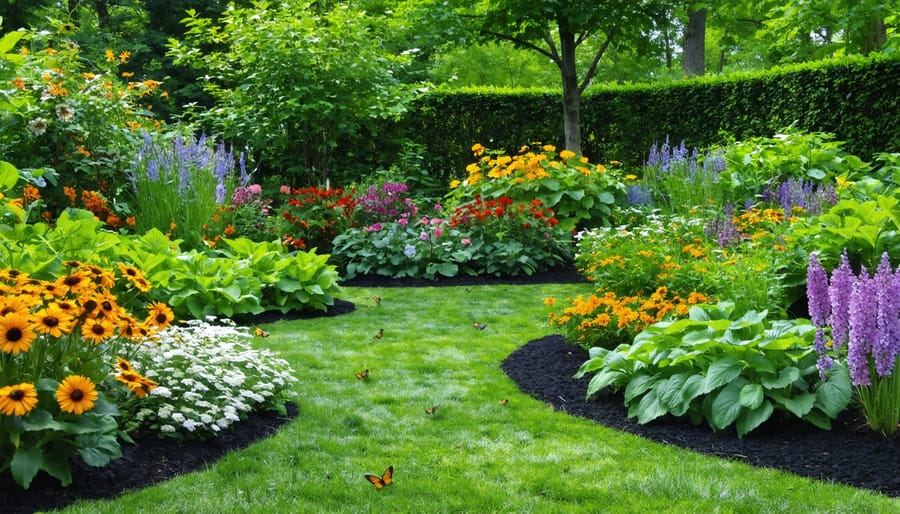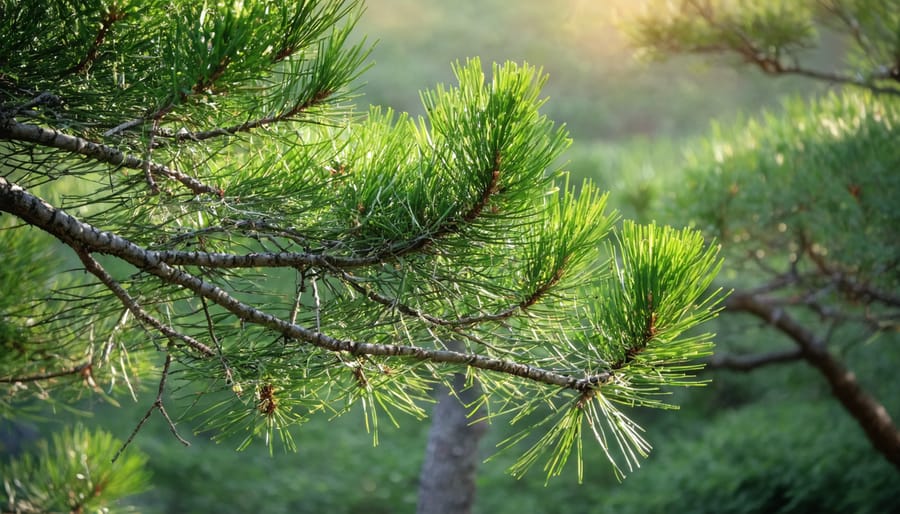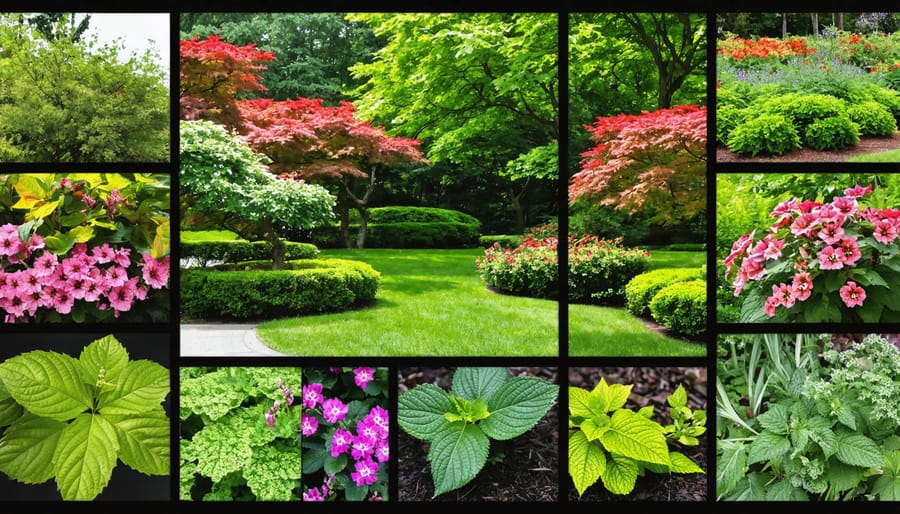Transform your outdoor space into a thriving ecosystem by replacing synthetic fertilizers with rich, homemade compost teeming with beneficial microorganisms. Layer organic mulch 2-3 inches deep around plants to naturally suppress weeds, retain moisture, and gradually feed the soil as it breaks down. Select native plants adapted to your local climate, requiring minimal intervention while attracting pollinators and supporting local wildlife. Create natural pest deterrents by interplanting aromatic herbs like lavender, rosemary, and thyme throughout your landscape beds.
Organic landscaping nurtures more than just plants – it builds living soil that grows healthier with each passing season. Beyond eliminating harmful chemicals, this approach works in harmony with nature’s own cycles, creating a resilient outdoor sanctuary that’s safe for children, pets, and beneficial insects. Whether you’re designing a new landscape or transitioning an existing garden, organic methods offer a sustainable path to create stunning outdoor spaces that improve with time.
The shift to organic landscaping isn’t just about what you don’t use – it’s about embracing practices that actively regenerate the environment while creating beautiful, low-maintenance spaces that connect you more deeply with nature.
Building Healthy Soil: The Foundation of Organic Landscaping
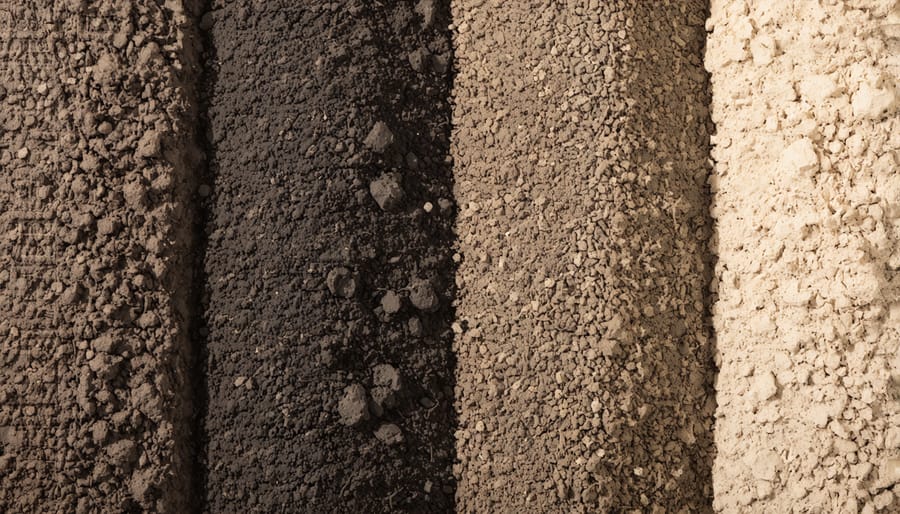
Natural Soil Testing and Amendment Methods
Understanding your soil’s composition and health is fundamental to successful organic landscaping. Through smart soil management, you can create the perfect foundation for your garden to thrive naturally.
Start by performing a simple jar test: fill a clear glass jar one-third full with soil, add water, shake well, and let it settle for 24 hours. The layers that form will show you the proportions of sand, silt, and clay in your soil. To test drainage, dig a hole 12 inches deep, fill it with water, and observe how quickly it drains.
For pH testing, you can use red cabbage juice as a natural indicator. Blend cabbage leaves with distilled water, strain the liquid, and mix with a soil sample. Purple indicates neutral soil, while pink suggests acidic conditions and blue-green shows alkaline soil.
To improve soil naturally, add organic matter through:
– Homemade compost from kitchen scraps and yard waste
– Well-aged manure from herbivorous animals
– Leaf mold from fallen autumn leaves
– Cover crops that can be tilled into the soil
Remember to mulch with natural materials like straw, wood chips, or pine needles to retain moisture and gradually enrich the soil as they decompose. This approach not only nourishes your plants but also supports beneficial soil organisms that maintain long-term garden health.
Composting for Ornamental Gardens
Composting is the heart of any successful organic ornamental garden, transforming everyday yard waste into black gold for your plants. Start by selecting a partially shaded spot in your garden for your compost pile or bin. The ideal mix combines “green” materials (fresh grass clippings, kitchen scraps, and spent flowers) with “brown” materials (fallen leaves, twigs, and paper) in roughly equal proportions.
For ornamental gardens, creating the right compost blend is crucial. Layer your materials, keeping them moist but not wet, and turn the pile every few weeks to speed up decomposition. Within 3-6 months, you’ll have rich, dark compost perfect for your flowering plants and ornamental shrubs.
Use your finished compost in multiple ways throughout your ornamental garden. Mix it into planting holes when adding new specimens, spread it as a 2-inch mulch layer around established plants, or brew it into compost tea for a natural liquid fertilizer. For delicate flowering plants, screen your compost through a wire mesh to create a finer texture that’s ideal for top dressing.
Remember to keep ornamental garden trimmings separate from diseased plants or invasive weeds, which shouldn’t go into your compost pile. Adding a handful of garden soil to your pile can introduce beneficial microorganisms that help break down the materials more efficiently.
Plant Selection for Organic Success
Native and Adapted Ornamentals
One of the most rewarding aspects of organic landscaping is working with native plants and adapted ornamentals that naturally thrive in your region. These plants have evolved to flourish in your local climate, requiring less water, fertilizer, and maintenance than exotic species. Plus, they create vital habitats for local wildlife, including beneficial insects and birds that help maintain a healthy garden ecosystem.
When selecting plants for your organic landscape, consider your specific growing zone and microclimate conditions. Look for species that match your soil type, sun exposure, and typical rainfall patterns. Native wildflowers like coneflowers, black-eyed susans, and blazing stars offer stunning blooms while supporting pollinators. Regional shrubs and trees provide structure and year-round interest while establishing deep root systems that prevent soil erosion.
Adapted ornamentals, while not native, have proven themselves capable of thriving in your area without excessive intervention. These plants offer additional variety while maintaining the low-maintenance benefits of native species. Consider incorporating drought-tolerant lavender, salvias, or ornamental grasses that complement your native plant selections.
Remember that establishing native and adapted plants takes patience. While they might grow slower initially, they’ll develop stronger root systems that make them more resilient and self-sufficient over time. This investment in appropriate plant selection pays dividends through reduced maintenance needs and a more sustainable landscape.
Companion Planting Strategies
Companion planting is one of the most effective and beautiful strategies in organic landscaping, where specific plants are grown together to benefit each other naturally. Think of it as creating plant neighborhoods where everyone looks out for each other!
Marigolds are the classic companion plant, acting as natural pest deterrents while adding cheerful pops of orange and yellow to your garden. Plant them around the borders of your ornamental beds to keep unwanted insects at bay. Lavender not only provides stunning purple blooms but also attracts beneficial pollinators while deterring deer and rabbits.
For a stunning vertical display, try growing climbing nasturtiums alongside flowering vines. The nasturtiums naturally repel aphids and whiteflies, protecting their climbing companions while creating an eye-catching display of colors. Herbs like rosemary, thyme, and sage make excellent companions for roses, helping to prevent black spot while adding fragrance and texture to your landscape.
Consider creating “guilds” of plants that support each other. For example, pair tall sunflowers with shade-loving coral bells beneath them. The sunflowers provide natural support and shade, while the coral bells help retain soil moisture and suppress weeds. Native plants are particularly good companions as they’ve evolved together and naturally complement each other’s growth patterns.
Remember that successful companion planting isn’t just about pest control – it’s about creating harmonious, self-sustaining garden spaces that delight the senses while supporting local ecology.
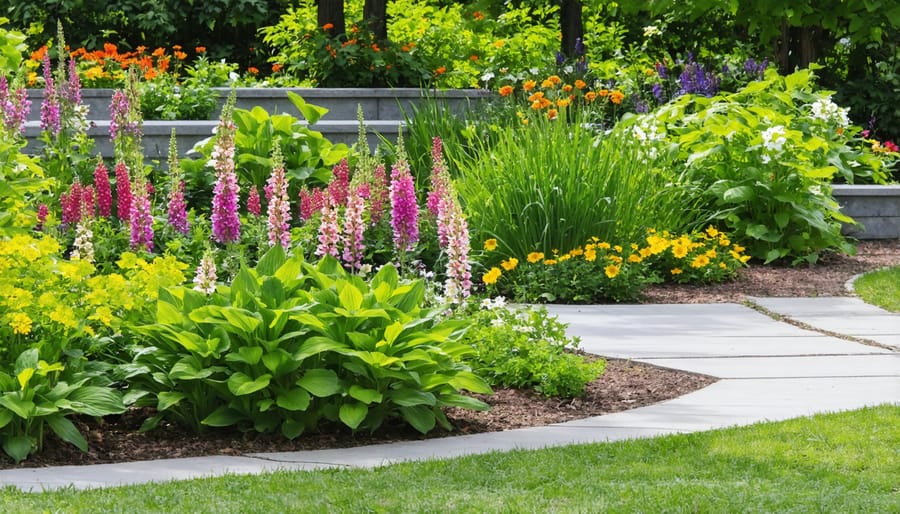
Natural Pest and Disease Management
Beneficial Insects and Wildlife
Creating a thriving ecosystem in your garden isn’t just about plants – it’s about welcoming nature’s helpful allies. Beneficial insects and wildlife play crucial roles in maintaining garden health naturally, making them essential partners in organic landscaping.
Ladybugs, praying mantises, and lacewings act as natural pest control, feasting on aphids and other problematic insects. Ground beetles patrol the soil surface, managing slug populations, while parasitic wasps help control caterpillars and other leaf-eating pests. Bees, butterflies, and hummingbirds serve as vital pollinators, ensuring your flowering plants thrive and reproduce.
To attract these garden helpers, incorporate diverse native plants that provide food and shelter. Plant flowers in clusters, offering landing pads for pollinators, and include varieties that bloom throughout the growing season. Marigolds, yarrow, and cosmos are excellent choices that attract beneficial insects while adding vibrant color to your landscape.
Create wildlife-friendly features like bird baths, small brush piles, and bee hotels. Leave some fallen leaves in garden beds during winter to provide shelter for beneficial insects. Adding a shallow water source with landing spots will attract birds and beneficial insects alike.
Remember that a few nibbled leaves are a small price to pay for a balanced ecosystem. When you welcome beneficial creatures to your garden, you’re creating a self-regulating environment that reduces the need for any pest control intervention, organic or otherwise.
Organic Solutions for Common Problems
Every garden faces challenges, but organic solutions offer effective and environmentally friendly remedies. For common pest issues, companion planting proves invaluable – marigolds naturally repel numerous insects, while nasturtiums act as sacrifice plants to protect your prized specimens. When dealing with persistent pests, consider implementing natural pest management solutions like introducing beneficial insects such as ladybugs and praying mantises.
For weed control, mulching serves multiple purposes: it suppresses unwanted growth, retains moisture, and gradually enriches your soil. Layer cardboard or newspaper beneath organic mulch for extra effectiveness. A solution of vinegar, salt, and dish soap can tackle stubborn weeds in pathways, though be cautious as this mixture affects all plants it touches.
Fighting plant diseases? Neem oil works wonders as a natural fungicide and insecticide. For powdery mildew, a mixture of one part milk to nine parts water, sprayed on affected leaves, often resolves the issue. Baking soda solutions (one tablespoon per gallon of water) help prevent fungal problems when applied preventively.
Soil fertility concerns can be addressed through compost tea, which provides both nutrients and beneficial microorganisms. For calcium deficiency, crushed eggshells around plants offer a slow-release solution that also deters slugs and snails.
Water-Wise Organic Practices
Smart Irrigation Methods
Water is a precious resource, and implementing efficient watering techniques is crucial for maintaining a thriving organic landscape. Start by installing a drip irrigation system, which delivers water directly to plant roots, reducing waste through evaporation and preventing water-related foliage diseases.
Consider adding a smart irrigation controller that adjusts watering schedules based on weather conditions and soil moisture levels. These devices can cut water usage by up to 50% while ensuring your plants receive exactly what they need. Mulching plays a vital role too – a 2-3 inch layer of organic mulch helps retain moisture and reduces watering frequency.
Group plants with similar water needs together in hydrozones. This practice ensures that no plant gets too much or too little water. Morning watering (between 5-9 AM) is ideal, as it minimizes evaporation and gives plants time to dry before evening, reducing disease risks.
Collecting rainwater in barrels or cisterns provides a free, chemical-free water source for your garden. You can also create slight depressions around plants or gentle swales in your landscape to direct and retain natural rainfall where it’s needed most.
Remember to water deeply but less frequently to encourage deep root growth, which helps plants become more drought-resistant and self-sufficient over time.
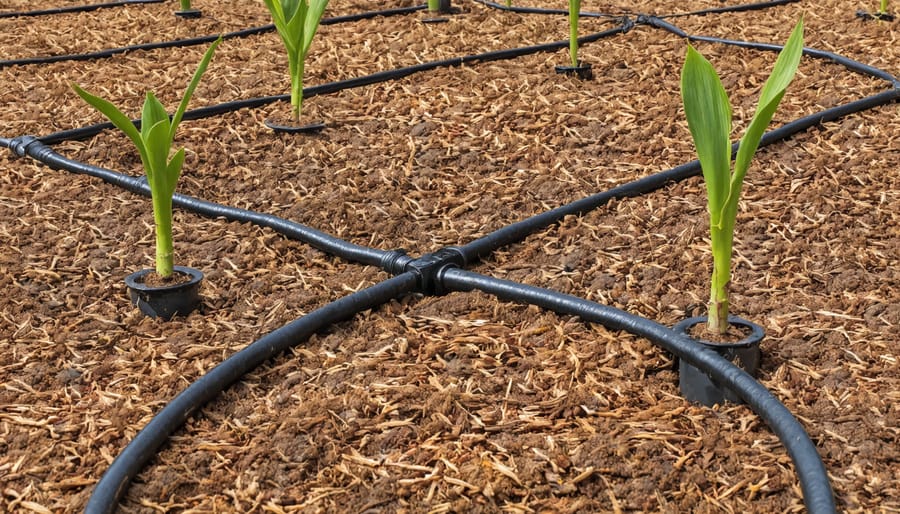
Mulching and Ground Cover Strategies
Mulching is one of the most effective strategies in organic landscaping, offering multiple benefits while maintaining your garden’s natural beauty. A 2-3 inch layer of organic mulch helps retain soil moisture, reducing water consumption by up to 30% and keeping your plants hydrated during dry spells.
Natural mulch materials like wood chips, straw, or leaf mold not only suppress weeds but also break down gradually to enrich your soil. For ornamental beds, consider using attractive options like pine needles or cocoa hulls, which add visual interest while performing their practical functions.
Living ground covers offer another excellent approach to sustainable landscaping. Low-growing plants like creeping thyme, sedum, or sweet woodruff create beautiful carpets of green that naturally prevent weed growth while providing habitat for beneficial insects. These plants work particularly well in areas where grass struggles to grow, such as under trees or on slopes.
For the best results, combine both strategies: use living ground covers as your first line of defense against weeds, then add organic mulch around larger plants and in spaces between ground covers. Remember to leave a small gap around plant stems and tree trunks to prevent rot and disease. Refresh your mulch annually in spring, adding just enough to maintain the recommended depth without smothering your plants.
Embarking on your organic landscaping journey is more than just a gardening choice – it’s a commitment to nurturing both your outdoor space and the environment. Throughout this guide, we’ve explored how organic methods can create stunning landscapes while supporting local ecosystems and promoting biodiversity. From selecting native plants and building healthy soil to implementing natural pest control solutions, these sustainable practices work together to create a thriving, chemical-free garden.
Remember that transitioning to organic landscaping doesn’t have to happen overnight. Start small by incorporating organic compost, reducing chemical inputs, or dedicating a portion of your yard to native plants. As you witness the positive changes – from increased butterfly visitors to healthier soil – you’ll feel inspired to expand your organic practices further.
The benefits of organic landscaping extend far beyond your property lines. You’re contributing to cleaner waterways, supporting essential pollinators, and creating a safer environment for children, pets, and wildlife. Plus, you’re joining a growing community of gardeners who are proving that beautiful landscapes don’t require synthetic chemicals to flourish.
Take that first step today. Whether it’s starting a compost pile, planting your first native species, or switching to organic fertilizers, every small action moves us toward a more sustainable future. Your organic landscape will become a source of pride, inspiration, and endless natural wonder.

